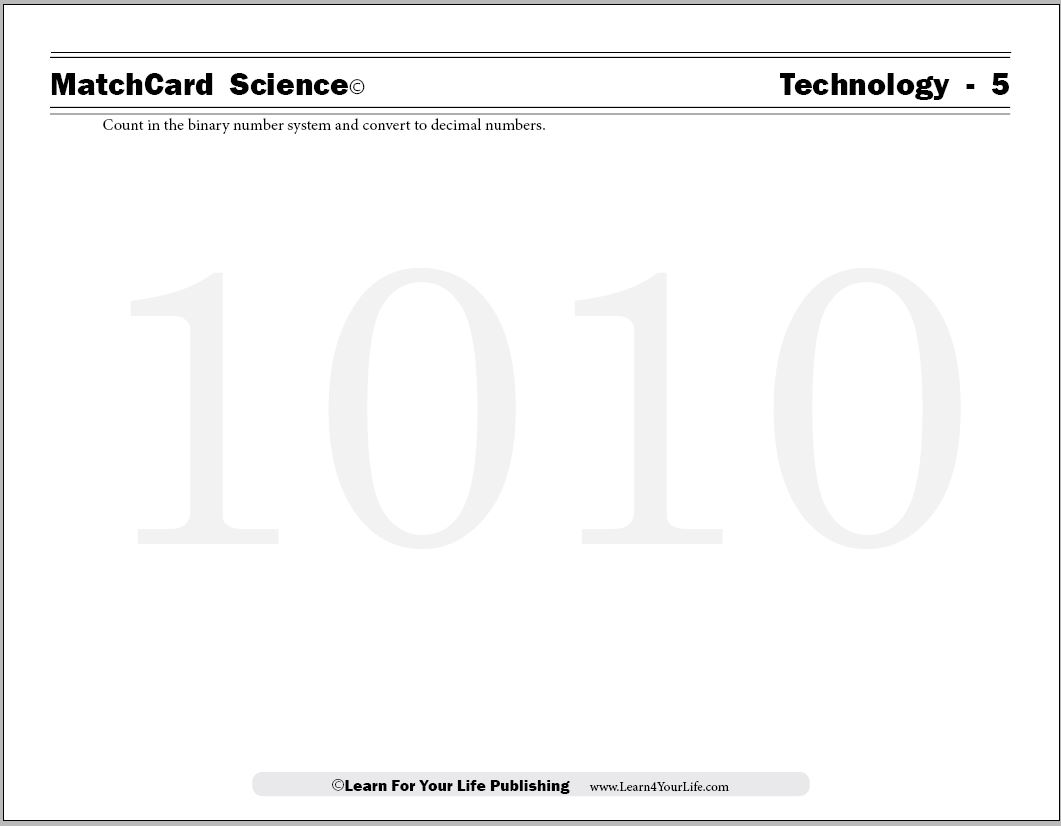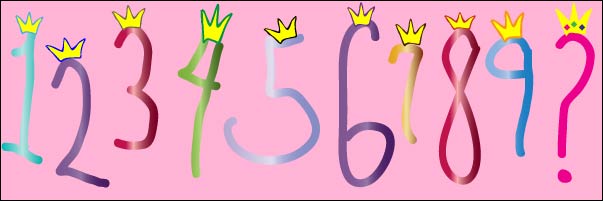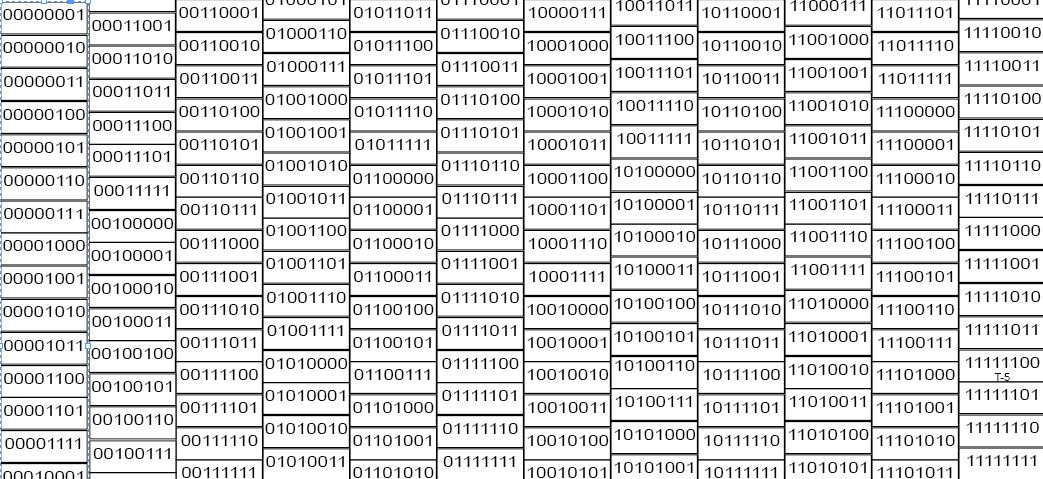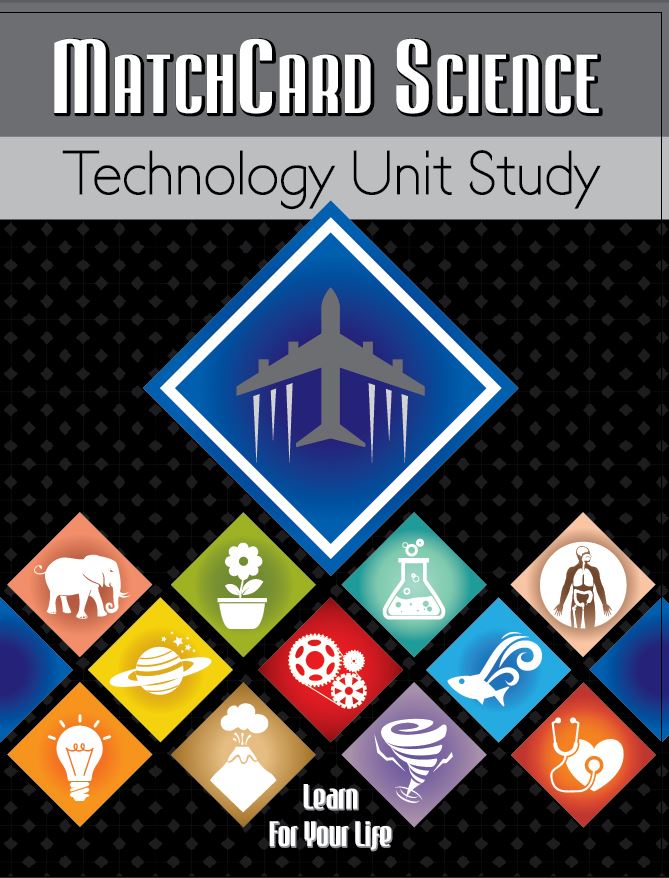Binary Games
Free download of binary games, flashcards, and worksheet below.
Free Download Below


MatchCard Science Binary Worksheett
Objective: Count in the binary number system and convert to decimal numbers.MatchCard: Download below.
MatchCard Information Pieces list binary numbers to 11,000,000. Two sets of flashcards (with and without decimal conversion numbers) are on the Technology Information Pieces. Games and activities listed below and on the Learning Activities sheet.
Print the Binary MatchCard


Click image to go to download.
This is MatchCard #5 of the Technology Unit Study. Find more information on MatchCard Science below.
Opening Activity to Teach the Number Systems
A Number Fairy Tale

Once upon a time there was a king with ten very talented, very beautiful, and highly intelligent princesses. The first princess was named “One,” the second princess was named “Two,” the next was named “Three.” Then came “Four,” followed by “Five,” and after her came Princess “Six.” It may not surprise you to hear that “Six” was followed by “Seven,” and then of course came “Eight,” who was followed by “Nine.” And then came....Hold it....Stop. You see, the next daughter was the favorite of the royal father who decreed that no one was ever allowed to say her name. Nor were they allowed to write it. So whenever anyone in the kingdom was counting and they would get to “Nine,” they couldn’t go on. So they just decided they would start over again whenever they got past “Nine.” So after 9 comes 10. And after 99 comes 100. And after 999 comes 1000, because the people did not want to go to jail for saying or writing the tenth daughter’s name. Oops - I just said it.
Okay, enough fiction. This is NOT how we got our decimal system which, in fact, was a brilliant advancement from the Middle East which allowed the average person to calculate numbers far faster than an accountant using the old Roman Numeral system.
Review Base Four
“Deci” means “ten” in Latin and may very well have been the name of the tenth princess in our story. The take home point is that the numbers repeat. We use a Base Ten number system, possibly because of ten fingers on the human hand. It seems so common and so obvious that it is hard to imagine any other number system. But for this lesson you will learn about two others.The Base Four System
If we aren’t allowed to say or write the secret number following number 9 in the Base Ten system, then we can’t say or write the 4 in the Base Four system. We would count:1,2,3,10, 11, 12, 13, 20, 21, 22, 23, 30, 31, 32, 33, 100, 101, 102, 103, 110, 111, 112, 113, 120, 121, 122, 123, etc.
The point is that you never reach the mysterious “four” but have to add another place value. Base Four doesn’t have a whole lot of practical value to the average person except that:
- Hypothetically recognize that Base Ten is not the only number system that can be used
- Makes it much faster if your mom sends you to your room to count to 1000 (you didn’t hear me say that.)
- Makes the binary number system a little more comprehensible. And the Binary System is VERY important. (Hint: computers use it.)
Counting In Base Four
Give a pile of small objects (like miniature M&M’s) and have them count outloud as fast as they can in Base Four. If they say “four” they are out. Then Mom gets the rest of the M&M's.More With Base Four
Your young math whizzes might like to have a little fun adding and subtracting in the Base Four system. Your super whizzes might even want to try their hand at multiplying and dividing. Now THAT takes committment.Binary Number System

So how do you count in Base Two?
- 1
- 10
- 11
- 100
- 101
- 111
Binary Information Pieces
Cut apart the Information Pieces for MatchCard #5 with the different binary numbers. Students place them in the correct order on the MatchCard or on a table top. The numbers are in order going down the page, not across. For students in 3rd & 4th grade you might just use one row of numbers. Use two or three rows for students in 5th or 6th grade. For younger students you may also cut off the leadeing zeros.Binary Flash Cards
This next activity will indicate how a computer “reads” a binary number. You will the eight flashcards included or you can make your own. Fold the cards so one side has a “0” and one side has a “1.”Give the student one of the numbers on the information piece. They have to lay out their card with the 0 or the 1 side facing up.
For instance the number 1011 would look like this:

From Bits to Bytes
In computer language a “bit” is one stroke - either the one or the zero. Each 1 is a bit and each 0 is a bit. The number to the left is composed of four bits.A byte is a series of eight bits. The byte would be written as:
00001011
So what does that byte mean? It refers to the quantity of 11 in the decimal system. In the next activity we will learn how to convert between the two different systems.Binary Games
Converting From Binary to Decimals
Use the other flashcards in the information pieces that have these numbers below the “1”:- 1
- 2
- 4
- 8
- 16
- 32
- 64
- 128

So what does this mean?
The binary number 101,011 is the same quantity as the decimal number 43 (32+8+2+1).
Binary to Decimal Games
Randomly pull one of the binary information pieces and convert it into the decimal number. You can do it as a contest with two or more players. They each have ten cards, and whoever can correctly convert all ten cards to decimal the first wins.Converting From Decimal to Binary
You will need a set of ten-sided dice to play this game. Alternative: two sets of cards from one to ten. Taking two of each of the cards Ace to 9 from a standard deck of playing cards will work, though you won’t have a zero.Roll the two dice (or draw two cards.) Write the number as a decimal number. Then use the binary cards you made (with the small decimal numbers beneath the one) and find what the number would be in the binary system.
For instance, the number 85 would be:

Starting on the left side find the first number that is smaller or equal to the decimal number you want to represent. Turn that number up. Go to the next number just to the right of the first number you turned up.
If you add those two digits will the sum be larger than the decimal number you are trying to make? If no, turn it up. If yes, keep it at zero and go to the next number. Keep passing or turning up cards until you have the correct decimal number. The zero’s and one’s will give you your binary number.
Binary War
You will need both sets of the binary numbers cut apart. Each player will have one set. Put them in an envelope or bowl and mix them up. Each player shows one of their cards. Whoever has the largest number keeps both cards. You can play a designated number of rounds (for instance - 20 rounds.)Binary Hot Potato
It helps to have four or more players for this game, though you can play it with only three. Use a small object for the “potato.” Start by counting from one in the binary system and keep going as fast as you can. If you have a timer that goes off, the person holding the potato loses that round.Binary Jump Rope
Just for fun, count in the binary system while jumping rope.MatchCard Science
How To Use MatchCards

Download the FREE MatchCard Science Instructor's Guide and see how MatchCards can make building their science knowledge base fun.
12 Science Unit Studies

Chemistry is only one of twelve complete unit studies for kids in 3rd to 8th grade.
Comprehensive objectives, hands-on projects, suggested science fair experiments, and the fun game-like MatchCards keep them interested in learning science. See all twelve MatchCard Science Unit Studies.
About Our Site
Hands-On Learning














